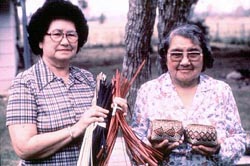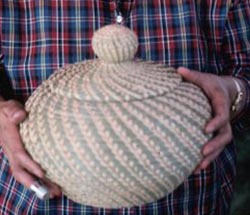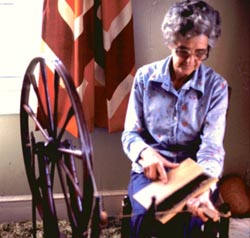Folk Crafts: A "Hand-Me-Down" Tradition
By C. Ray Brassieur
Our ancestors learned to deal with the world by imitating family and community members as they went about solving daily problems. The skills and knowledge needed to perform everyday tasks were generally handled from master to apprentice, parent to child, elder to youth, person to person, from one generation to the next. These traditional skills and understandings, time-honored resources that insured the success of the individual and the community, are now called folk crafts. Despite mass education, industrial modernization, the onslaught of the computer, and "Sesame Street," folk crafts continue to exist and perpetuate in our late twentieth century world.

It is somewhat amazing that folk crafts persist within our modern society. Mass production and the availability of new industrial materials and processes are among the most powerful forces adversely affecting the persistence of traditional arts and skills. For well over a century, the traditional Acadian weaver has been unable to compete with the textile mills. As soon as there were lumber mills producing cypress planks, the handmade dugout pirogue declined in practicality. Now that sheet aluminum and fiberglass are available, it is becoming special to see a wooden boat of any type. Our industrial society, what's more, has depleted the environment of a number of resources once used by traditional craftspeople. Chitimacha Indian baskets, for instance are made from a certain bayou grass that is becoming difficult to find. Traditional crafts utilizing Spanish moss have been devastated by the depletion of this epiphyte.
How is it, then, that Acadian weavers, dugout pirogue and wooden boatbuilders, Chitimacha basketmakers and braiders of Spanish moss still practice their skills in Louisiana today? Fortunately, there are a number of factors that encourage the retention and development of folk crafts. Various federal, state and local governmental agencies, for example, have been successful in bringing attention and respect to our traditional folk heritage. In retrospect, we can credit governmental policy with the revival of certain nearly extinct folk crafts. During the 1930s and 40s, several WPA projects coincided with efforts of the Louisiana Home Demonstration Agencies and the Louisiana Agricultural Extension Service to encourage the few extant Acadian weavers to expand and capitalize on their craft. At the same time, Coushatta Indians were similarly encouraged to pursue pine needle basketry. In these two examples, government agencies chose to encourage traditional crafts as a practical reaction to "poor times." During the depression, the shortage of money and of goods was somewhat ameliorated by the development of home industries and folk crafts. As unemployment rates remain high in Louisiana, present economic trends are undoubtedly having a similar impact on the retention and development of folk industries.
Other than governmental policy, there are many factors that could stimulate the development of traditional crafts. Recently, Cajun cooking, music, accordion making, weaving and other lifeways have sustained a rise in popularity which some attribute to an ethnic revival. Such revivals have the potential to instill pride in cultural elements that set one ethnic group apart from another. The distinctive stylistic difference between Chitimacha double-weave baskets and other Louisiana baskets becomes a source of ethnic pride that in turn encourages the growth of that craft.
This phenomenon may be somewhat related to the general search for quality that is being experienced in market trends today. As consumers in an industrial society, we are constantly bombarded with cheap, poorly fabricated, mass-produced, self-destructing products. The words "handmade," "old-fashioned," and "folk craft" have in many cases come to represent quality. After all, the quality of a handmade hickory ladder-back chair with a rawhide seat speaks for itself for decades if not centuries. On a cold February night, Grandma's cotton-insulated quilt takes on value, especially if it is only a memory you have as you shiver under a rayon blanket. Undoubtably, our nostalgic groping for the "good old days" has some relation to a perceived quality of life made possible by folk ingenuity.
For whatever reasons folk crafts persist in Louisiana, they proliferate in great variety throughout the entire state. Many of the crafts are related to occupation/subsistence strategies that developed in certain geographic areas. Throughout "dry land" rural Louisiana from the northwestern hills to the Mississippi Valley and down through the southwestern prairies and southern natural bayou levees where farming and ranching are important, crafts suited to the agrarian life abound. Blacksmiths, saddle makers, harness, yoke and rope makers are still practicing. More rare are the wheelwrights; called upon to repair an occasional trail ride wagon, they are not common. In west-central Louisiana there are still builders of traditional hewn and joined pole barns and corn cribs. Scattered throughout all rural regions of Louisiana, there are farmers who yet plow with mules and north of Lake Pontchartrain, there seems to be a revival of the use of draft horse power.
In southern "wet land" Louisiana, along the Gulf coastal marshes, in the region of the Atchafalaya swamp, on the banks of large lakes, bays, bayous, and rivers, other occupational/subsistence activities remain. Boatbuilders are numerous; many still sew their own hoop nets and carve their own paddles. And there, where the annual migratory flocks winter, a great florescence of duck carving is taking place. There are traditional craftspeople who still carve decoys with which to hunt ducks; there are many more who carve ducks to sit on living room mantels. As one duck carver informed me, "When we were kids, ducks would decoy to a chunk of wood or a dirt clod. As time went on, the ducks became more wary of the shotgun and the decoy carver had to add more realism and accuracy to his wooden bird. Now a duck won't land among decoys unless he recognizes some of them as friends and family."




